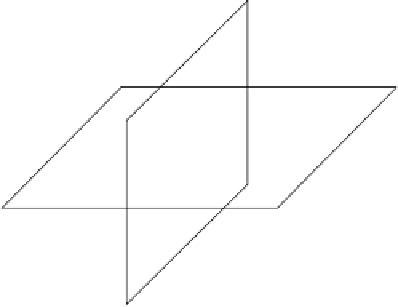Graphics Reference
In-Depth Information
n
1
P
n
2
n
1
×
n
2
p
2
p
1
Figure 5.30
The intersection of two planes.
in the plane equations forms a 2
×
2 system of linear equations.
n
1
·
(
k
1
n
1
+
k
2
n
2
)
=
d
1
n
2
·
(
k
1
n
1
+
k
2
n
2
)
=
d
2
.
By virtue of the linearity of the dot product, this is equivalent to
k
1
(
n
1
·
n
1
)
+
k
2
(
n
1
·
n
2
)
=
d
1
k
1
(
n
1
·
n
2
)
+
k
2
(
n
2
·
n
2
)
=
d
2
,
which can be solved for
k
1
and
k
2
(by Cramer's rule, for example) to give the solution
k
1
=
(
d
1
(
n
2
·
n
2
)
−
d
2
(
n
1
·
n
2
))/
denom
k
2
=
(
d
2
(
n
1
·
n
1
)
−
d
1
(
n
1
·
n
2
))/
denom
,
where
n
2
)
2
.
denom
=
(
n
1
·
n
1
)(
n
2
·
n
2
)
−
(
n
1
·
A direct implementation of these expressions gives the following code.
// Given planes p1 and p2, compute line L = p+t*d of their intersection.
// Return 0 if no such line exists





